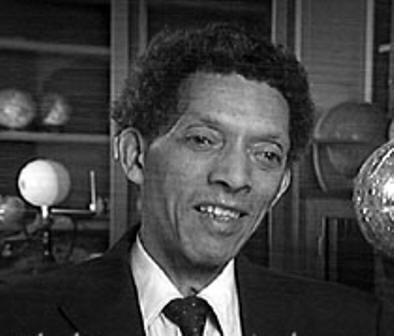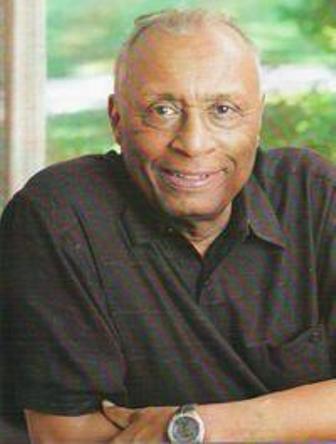If we're talking about the past 200 years or so then yea, he's right. Black people haven't really contributed shyt, but alltime dude is a clown. Fucc him
Gerald Anderson “Jerry” Lawson was an American electronic engineer known for his work in designing the Fairchild Channel F video game console.
During development of the Channel F in the early-mid 1970s, Lawson was Chief Hardware Engineer and director of engineering and marketing for Fairchild Semiconductor’s video game division. He also founded and ran Videosoft, a video game development company which made software for the Atari 2600 in the early 1980s, as the 2600 had displaced the Channel F as the top system in the market.
Lawson along with Ron Jones were the sole black members of the Homebrew Computer Club, a group of early computer hobbyists which would produce a number of industry legends, including Apple founders Steve Jobs and Steve Wozniak. Lawson also produced one of the earliest arcade games, Demolition Derby, which debuted in a southern California pizzeria shortly after Pong. Lawson later worked with the Stanford mentor program and was preparing to write a book on his career.
Lewis Latimer (1848 – 1928)
What He Invented: The Carbon Filament For The Light Bulb.
Why It’s Important: Latimer is one of the greatest inventors of all time. Thomas Edison may have invented the electric lightbulb, but Latimer helped make it a common feature in American households. In 1881 he received a patent for inventing a method of producing carbon filaments, which made the bulbs longer-lasting, more efficient and cheaper.
In 1876, he worked with Alexander Graham Bell to draft the drawings required for the patent of Bell’s telephone.
As a child, Mark Dean excelled in math. In elementary school, he took advanced level math courses and, in high school, Dean even built his own computer, radio, and amplifier. Dean continued his interests and went on to obtain a bachelor's degree in electrical engineering from the University of Tennessee, a masters degree in electrical engineering from Florida Atlantic University and a Ph.D. in electrical engineering from Stanford. He is one of the most prominent black inventors in the field of computers.
Dr. Mark Dean started working at IBM in 1980 and was instrumental in the invention of the Personal Computer (PC). He holds three of IBM's original nine PC patents and currently holds more than 20 total patents. The famous African-American inventor never thought the work he was doing would end up being so useful to the world, but he has helped IBM make instrumental changes in areas ranging from the research and application of systems technology circuits to operating environments. One of his most recent computer inventions occurred while leading the team that produced the 1-Gigahertz chip, which contains one million transistors and has nearly limitless potential.
African American inventor Henry Sampson is a brilliant and accomplished nuclear physicist who invented a Gamma-Electrical Cell. Henry Sampson also received patents for a "binder system for propellants and explosives" and a "case bonding system for cast composite propellants." Both inventions are related to solid rocket motors.
Henry Sampson was born in Jackson Mississippi, where he graduated from Lanier High School in 1951. He went on to attend Morehouse College for two years, then transferred to Purdue University where he graduated with a B.S. Degree in Chemical Engineering. Continuing on to graduate school, Henry Sampson attended UCLA where he was awarded a Masters in Engineering in 1961. Sampson also received his MS in Nuclear Engineering from the University of Illinois Urbana-Champaign, in 1965, and his PHD in 1967. He is the first African American to earn a Ph.D.in Nuclear Engineering in the United States.
Sampson was employed as a research chemical engineer at the U.S. Naval Weapons Center, China Lake, California, in the area of high energy solid propellants and case bonding materials for solid rocket motors. Henry Sampson also served as the Director of Mission Development and Operations of the Space Test Program at the Aerospace Corporation in El Segundo, California.
His patents included a binder system for propellants and explosives and a case bonding system for cast composite propellants. Both inventions are related to solid rocket motors. He received a patent, with George H. Miley, for a gamma-electrical cell on July 6, 1971.
On July 6, 1971, Sampson was awarded a patent for the “gamma-electric cell”, which pertains to Nuclear Reactor use. (U.S. Patent 3,591,860) This invention produces stable high-voltage output and current to detect radiation in the ground.
His Gamma-Electric cell device converts nuclear radiation from reactors or isotopes, directly into electricity without going through a heat cycle. In the nuclear fusion process, which involves the splitting of atom, radioactive materials emit ionizing radiation that can cause serious damage to living tissues. Constructive methods to convert these powerful radiating energies into practical and safe energy sources, is the fundamental philosophy behind the development of Sampson's Gamma-Electric Cell.
Henry Sampson is also a writer and film historian who wrote a book entitled,
"Blacks in Black and White: A Source Book on Black Films." Since its acclaimed publication in 1977 as a pioneering work, this has remained the first and only book to detail all aspects of a unique era in the history of motion pictures, the only time in the U.S. when films featuring an all-Black cast, produced and directed by Blacks, were shown primarily to Black audiences, in theatres many of which were owned and managed by Blacks.
Henry Sampson traces the history of the Black film industry from its beginnings around 1910 to its demise in 1950, chronicling the activities of pioneer Black filmmakers and performers who have been virtually ignored by film historians. Henry T. Sampson has also written "Blacks in Blackface: A Source Book on Early Black Musical Shows" and "The Ghost Walks: A Chronological History of Blacks in Show Business, 1865-1910".
Some of Henry Sampson's accomplishments include being a member of the United States Navy between the years 1962 and 1964 and earning an Atomic Energy Commission honor between 1964 and 1967. Later he was awarded the Black Image Award from Aerospace Corporation in 1982. He was awarded the Blacks in Engineering, Applied Science Award, and prize for education, by the Los Angeles Council of Black Professional Engineers in 1983.

George Carruthers is an African American inventor, physicist, and space scientist. He has gained international recognition for his work which focuses on ultraviolet observations of the earth's upper atmosphere and of astronomical phenomena. George Carruthers first major contribution to science was to lead the team that invented the far ultraviolet camera spectrograph. Dr. Carruthers received a patent for his invention the "Image Converter for Detecting Electromagnetic Radiation specially in Short Wave Lengths" on November 11, 1969. He also developed the first moon based space observatory, an ultraviolet camera that was carried to the moon by Apollo 16 astronauts in 1972.

Imagine living in a world ranging from hazy, clouded vision to that of total darkness for 30 years. Before 1985, that was the plight of those with cataracts who did not want to risk surgery with a mechanical grinder. Now imagine sitting in a doctor's office without being able to see her as she explains that it may be possible to restore your vision. You can't tell by studying body language whether to trust this person or if they're pulling your leg. All you have to go by is the sound of the voice assuring you that this procedure is safe, more accurate and more comfortable than traditional cataract surgery.
As a noted Opthamologist and famous black inventor, Dr. Patricia Bath has dedicated her life to the treatment and prevention of visual impairments. Her personal belief that everyone has the "Right to Sight" led to her invention in 1985 of a specialized tool and procedure for the removal of cataracts. With the Laserphaco Probe and procedure, Dr. Bath increased the accuracy and results of cataract surgery, which had previously been performed manually with a mechanical grinder.
The difference between the old method and her new invention was the difference between the use of highly accurate laser technology and the somewhat subjective accuracy of a mechanical device. The Laserphaco Probe combined an optical laser, irrigation system and suction tubes. In use, the laser is inserted into a tiny incision on the eye; the laser then vaporizes the cataract and lens material, which is removed via the suction tubes. A replacement lens is then inserted on the eye.
With the Laserphaco Probe invention and the development of the procedure for its use, Dr. Bath helped restore the sight of several people who had been blinded by cataracts for up to 30 years. Imagine the joy they felt when they opened their eyes to see Dr. Patricia Bath's smiling face for the first time.
Did you ever think of what it might be like if your television could project the on-screen image directly into your living room as a 3-Dimensional image? Maybe not, but if it happens, you'll have African-American inventor Valerie Thomas to thank for it.
From 1964 to 1995, Thomas worked in a variety of capacities for NASA where she developed real-time computer data systems, conducted large-scale experiments and managed various operations, projects and facilities. While managing a project for NASA's image processing systems, Thomas' team spearheaded the development of "Landsat," the first satellite to send images from space.
In 1976, Thomas learned how concave mirrors can be set up to create the illusion of a 3-dimensional object. She believed this would be revolutionary if technology could be harnessed to transmit this illusion. With an eye to the future, Valerie Thomas began experimenting on an illusion transmitter in 1977. In 1980, she patented it. In operation, concave mirrors are set up on both ends of the transmission. The net effect of this is an optical illusion of a 3-dimensional image that looks real on the receiving end. This brilliant innovation placed Thomas among the most prominent black inventors of the 20th century.
NASA continues to use her technology and is exploring ways to use it in surgical tools and possibly television and video.










 Why did
Why did  There's plenty of folks on this forum that'll dispute that. Classical music came from Black folks too according to black historians/scholars.
There's plenty of folks on this forum that'll dispute that. Classical music came from Black folks too according to black historians/scholars.
